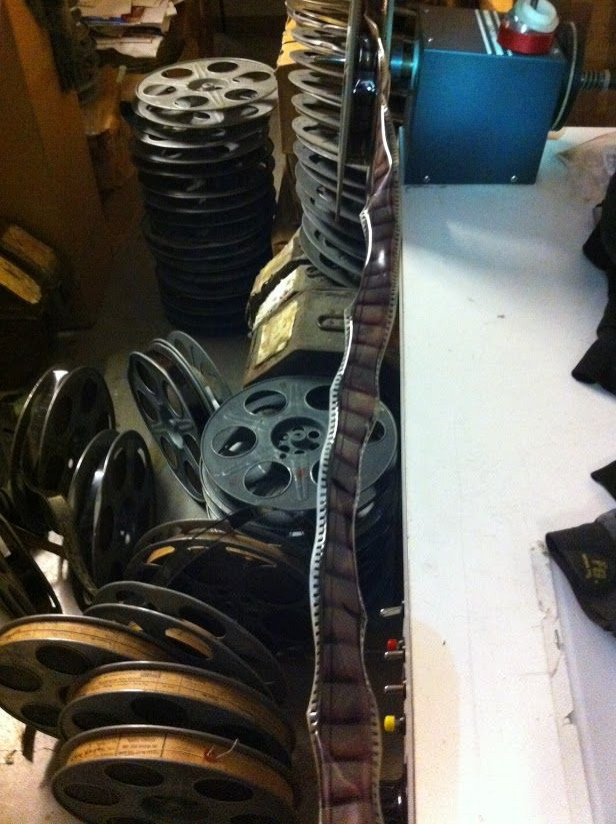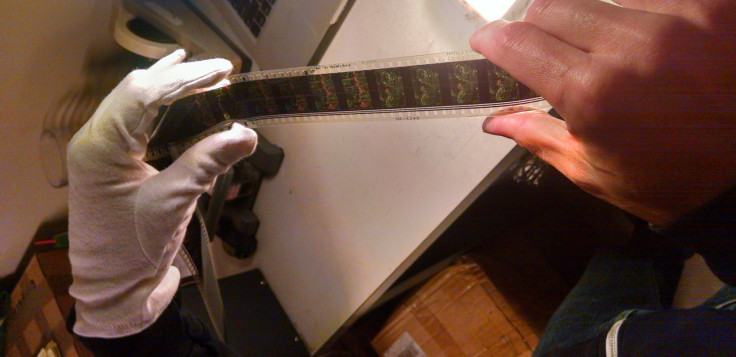“Eastman 1984 film stock. Excellent color, no fading. Heavy scratching throughout, both cell and emulsion side,” Sebastian del Castillo, chief archivist of the American Genre Film Archive (AGFA), types into its extensive database.
A few feet of brown ribbon has been spooled out in a dim room overwhelmed with stacked, sagging cardboard boxes. Light it from underneath and half-naked tribesmen and tribeswomen are revealed in each panel.
Right now it’s an inert item, but speed this reel up to 24 frames per second on a two projector changeover system (film archivists avoid platter projection, with its labyrinthine, potentially damaging rollers) and you’ll witness some of the most refined cruelty in cinema history. This is Cannibal Ferox, Italian director Umberto Lenzi’s infamous cannibal film, and it’s both a roaring riot of depraved tortures and a fragile object with beautiful color and heavy scratching throughout.
Without the work of film archivists movies like Cannibal Ferox might be reduced to VHS mud or lost to the world entirely.

The American Genre Film Archive was formed in 2009 and in a few short years has become the largest archive of its kind in the world, preserving the independent exploitation movies of the 60s, 70s and 80s. The collection contains 3,200 films and nearly as many trailers, sprawled over three different Alamo Drafthouse locations in Austin, Texas.
Thanks to filmmakers like Quentin Tarantino, Robert Rodríquez, Nicolas Wending Refn and Paul Thomas Anderson grindhouse cinema is famous once more. But like with so much of the remains of the analog world, age and neglect often outweigh the public’s passing interest.

Castillo gestures to case after case of stacked film reel canisters, all movies that recently belonged to the San Francisco film depot of Tai Seng Entertainment. “This was actually going to be dumped in the ocean. They were liquidating their 35mm assets and it was cheaper to dump them in the ocean instead of take them to the dump,” Castillo says, then repeats it with evident horror, “They were actually going to load this stuff up on a barge and take it out in the bay of San Francisco and dump it.”
“Our two film programmers at the time, Lars Nilsen and Zack Carlson, caught wind of it and they went down there on a rescue mission,” he says.
In their heyday exploitation movies were often screened alongside pornography, placing prints in precarious positions of ill repute. Most of the movies in the AGFA were never the studio’s treasures and didn’t accrue the obvious artistic prestige that might have safeguarded them into the modern day.
Many of the AGFA’s acquisitions are in bulk, neglected archives sold at “about $5 a print,” with exploitation movies peppered among X-rated 70s pornos (resulting in a strange ad hoc barter economy, with the AGFA trading porn for exploitation with the more sexploitation oriented Vinegar Syndrome label).
“In their lives these prints weren’t really taken good care of,” Castillo says. “The theaters that they were projected in were not the best and did not have the best projectionists. Grindhouse films, drive-in films--not a lot of TLC went into projecting them and storing them.”
After saving film from liquidation, a lot can go wrong. “It might come to us and have vinegar syndrome, which makes the acetate film really warpy and really brittle. Some of that stuff is unplayable. You open the can and it’s just garbage,” Castillo says. “It won’t make it through a projector and if it did it’d look terrible.”

“Usually I open it up and I can tell if it’s going to be really bad by the smell,” Castillo says, demonstrating by opening a case and giving the reel a big huff. “You don’t want to get too close, otherwise it’s going to destroy your nose.”
Even without a nose, much of the collection bears the obvious marks of decades of neglect. “These cases are not in the best shape,” Castillo says, but it’s an understatement. The heavy metal cases, corroded with rust, look like they’ve been dropped into war zones. “It’s really bad for the film. It’s going to speed up the decay.”
The situation is even more dire than battered cases, since film destroys itself. “It’s a natural process for acetate film to decay,” Castillo says. “But it’s definitely sped up by heat and humidity. Especially humidity.”
Film preservation may be an asymmetric battle against age and rot, but the rewards can be great. Castillo points out some of his favorites on the archive shelves. “Surf II is one that I really love. So far that’s only available on VHS. I really want to have it on Blu-ray. Blind Rage is really cool,” Castille says, pointing to another reel. “Fred Williamson’s in it. It’s a movie about blind men who are bank robbers.”
Over there is Frank Henenlotter’s classic. “Of course Basket Case is great.” Intriguing titles are everywhere, sometimes only half-visible in the dim projectionist hallways above the multiplex screens. Torture Dungeon. Satan Was a Lady. Chained Heat. Vigilante. Dead People.
Sometimes miracles happen here too. “I pulled a print the other day of To Paris With Love,” Castillo says. It’s a 1955 romance starring Alec Guinness; an atypical movie to find in the AGFA.
“An almost pristine Technicolor print,” Castillo says, recalling his initial reaction. “Wow, this is weird.”
The archive has even uncovered movies thought to be lost, like The Cocktail Hostesses, co-written by bad movie legend Ed Wood.
Still, when on the shelves or spooled out on the repair table the AGFA is just mile after mile of still frames. Movies are meant to be screened. After repairing broken perforations, tears, and bad splices, the AGFA ships prints out around the country.
The American Genre Film Archive has big plans for the future. A collaboration with Something Weird, the legendary exploitation film distributor founded by Mike Vraney in 1990, will add new titles to the archive with plans for theatrical, Blu-ray and VOD release. And after a successful Kickstarter the AGFA is ready to bring the archive into the digital world, with a new 4K film scanner.
Their first project will be digitizing and restoring The Zodiac Killer, a 1971 Tom Hanson movie the AGFA has described as “the most outrageous and compelling ‘tabloid horror’ vortex in the history of planet Earth.” It’s a fitting pick for an organization dedicated to the kind of preservation efforts usually reserved for the arthouse.














![[EG April 19] Best 'Stardew Valley' Mods That Will Change](https://d.player.one/en/full/226012/eg-april-19-best-stardew-valley-mods-that-will-change.png?w=380&h=275&f=955520b8313253ee3c39c791f6210f38)



